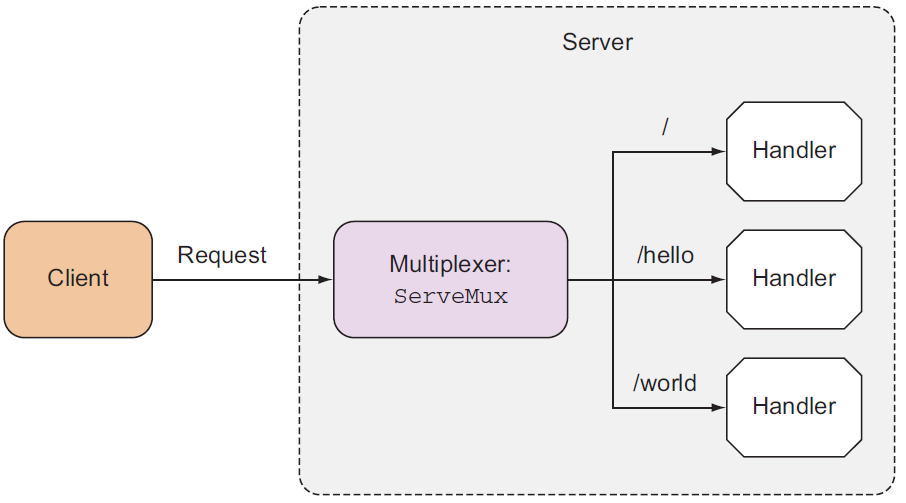Go Web:自带的ServeMux multiplexer
ServeMux简介
ServeMux扮演的角色是Multiplexer,它用来将将请求根据url路由给已注册的handler。如下图:

上图中为3个路径注册了handler,一个是"/",另外两个是"/hello"和"/world"。这表示访问http://hostname/hello时,multiplexer会调用上图中对应的第二个handler,当访问http://hostname/world时,multiplexer会调用上图中对应的第三个handler,当不是这两个路径时,将调用第一个绑定在"/"上的handler。
注意,go的mux路由请求时,handler绑定的路径是否带尾随"/"是不一样的。带上尾随"/",表示此路径以及此路径下的子路径,都会调用注册在此路径上的handler。
例如,当请求uri为"/hello/abc"的时候,不会调用"/hello"对应的handler,而是调用"/"对应的handler。只有注册handler的路径为"/hello/"时,uri为"/hello/abc"才会调用此handler。
实际上,当注册handler的路径带上尾随斜"/"时,在发起此路径的请求时,会通过301重定向的方式自动补齐这个尾随斜线,让浏览器发起第二次请求。例如,下面是注册handler的路径:
http.Handle("/hello/", &myHandler)
发起http://hostname/hello的请求时,会自动补齐为http://hostname/hello/,然后浏览器自动发起第二次请求。
ServeMux的匹配规则
ServeMux对每次流入的http请求的URL进行模式(pattern)匹配,然后调用注册在此pattern上的handler来处理这个请求。
Pattern部分可以定义为匹配host的模式。如果pattern以"/"开头,表示匹配URL的路径部分,如果不以"/"开头,表示从host开始匹配。
匹配时选择匹配匹配度最高(长匹配优先于短匹配)。例如为"/images/"注册了handler1,"/images/thumbnails/"注册了handler2,如果请求的URL路径部分为"/images/thumbnails/",将会调用handler2处理这个请求,如果请求的URL路径部分为"/images/foo/",将调用handler1处理。
注意,注册在"/"上的pattern会在其它模式匹配不上时被选中,因为所有请求都可以匹配这个pattern,只不过能匹配到的长度最短。
如果pattern带上了尾随斜线"/",ServeMux将会对请求不带尾随斜线的URL进行301重定向。例如,在"/images/"模式上注册了一个handler,当请求的URL路径为"/images"时,将自动重定向为"/images/"。除非再单独为"/images"模式注册一个handler。
如果为"/images"注册了handler,当请求URL路径为"/images/"时,将无法匹配该模式。
ServeMux详细解释
看看net/http/server.go文件中ServeMux的结构:
type ServeMux struct {
mu sync.RWMutex
m map[string]muxEntry
hosts bool // whether any patterns contain hostnames
}
type muxEntry struct {
h Handler
pattern string
}
结构看上去很简单。一个字段mu是RWMutex,m是注册handler和pattern的,hosts用于判断pattern是否包含了host的匹配。看看Handle()函数的定义会更清晰:
func (mux *ServeMux) Handle(pattern string, handler Handler) {
mux.mu.Lock()
defer mux.mu.Unlock()
if pattern == "" {
panic("http: invalid pattern")
}
if handler == nil {
panic("http: nil handler")
}
if _, exist := mux.m[pattern]; exist {
panic("http: multiple registrations for " + pattern)
}
if mux.m == nil {
mux.m = make(map[string]muxEntry)
}
mux.m[pattern] = muxEntry{h: handler, pattern: pattern}
if pattern[0] != '/' {
mux.hosts = true
}
}
// HandleFunc registers the handler function for the given pattern.
func (mux *ServeMux) HandleFunc(pattern string, handler func(ResponseWriter, *Request)) {
mux.Handle(pattern, HandlerFunc(handler))
}
pattern为空或者handler为空时,都会panic。此外,想要定义重复的pattern,也会panic。如果pattern的第一个字符不是"/",则表示这个pattern是从主机名开始匹配的。
唯一需要注意的是,每个Handle()都会对ServeMux实例加上写锁。
以常用的DefaultServeMux为例,它是ServeMux的一个实例。当使用DefualtServeMux时,每调用一次Handle()或HandleFunc(),都意味着向这个DefaultServeMux的结构中的m字段添加pattern和对应的handler。由于加了写锁,如果使用多个goroutine同时启动多个web服务,在同一时刻将只能有一个goroutine启动的web服务能设置DefaultServeMux。当然,一般情况下不会使用goroutine的方式同时启动多个web服务。
第三方ServeMux
自带的默认的DefaultServeMux其实功能限制很大。比如请求的URL路径为"/images/123.png",想要匹配这个确实容易,但是想要取出其中的"123.png"字符串,DefaultServeMux就没法实现。
有一个非常强大的Gorilla工具包(www.gorillatoolkit.org),它有好几个功能,其中一个功能是提供multiplexer。
转载请注明出处:https://www.cnblogs.com/f-ck-need-u/p/10020942.html
如果觉得文章不错,不妨给个打赏,写作不易,各位的支持,能激发和鼓励我更大的写作热情。谢谢!

Linux系列文章:https://www.cnblogs.com/f-ck-need-u/p/7048359.html
Shell系列文章:https://www.cnblogs.com/f-ck-need-u/p/7048359.html
网站架构系列文章:http://www.cnblogs.com/f-ck-need-u/p/7576137.html
MySQL/MariaDB系列文章:https://www.cnblogs.com/f-ck-need-u/p/7586194.html
Perl系列:https://www.cnblogs.com/f-ck-need-u/p/9512185.html
Go系列:https://www.cnblogs.com/f-ck-need-u/p/9832538.html
Python系列:https://www.cnblogs.com/f-ck-need-u/p/9832640.html
Ruby系列:https://www.cnblogs.com/f-ck-need-u/p/10805545.html
操作系统系列:https://www.cnblogs.com/f-ck-need-u/p/10481466.html
精通awk系列:https://www.cnblogs.com/f-ck-need-u/p/12688355.html




【推荐】国内首个AI IDE,深度理解中文开发场景,立即下载体验Trae
【推荐】编程新体验,更懂你的AI,立即体验豆包MarsCode编程助手
【推荐】抖音旗下AI助手豆包,你的智能百科全书,全免费不限次数
【推荐】轻量又高性能的 SSH 工具 IShell:AI 加持,快人一步
· SQL Server 2025 AI相关能力初探
· Linux系列:如何用 C#调用 C方法造成内存泄露
· AI与.NET技术实操系列(二):开始使用ML.NET
· 记一次.NET内存居高不下排查解决与启示
· 探究高空视频全景AR技术的实现原理
· 阿里最新开源QwQ-32B,效果媲美deepseek-r1满血版,部署成本又又又降低了!
· AI编程工具终极对决:字节Trae VS Cursor,谁才是开发者新宠?
· 开源Multi-agent AI智能体框架aevatar.ai,欢迎大家贡献代码
· Manus重磅发布:全球首款通用AI代理技术深度解析与实战指南
· 被坑几百块钱后,我竟然真的恢复了删除的微信聊天记录!